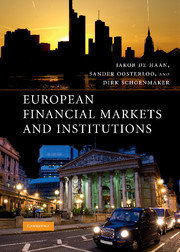Book contents
- Frontmatter
- Contents
- List of Boxes
- List of Figures
- List of Tables
- List of Countries
- List of Abbreviations
- Preface
- Part I Setting the Stage
- Part II Financial Markets
- Part III Financial Institutions
- 6 The Role of Institutional Investors
- 7 European Banks
- 8 The Financial System of the New Member States
- 9 European Insurers and Financial Conglomerates
- Part IV Policies for the Financial Sector
- Index
- References
7 - European Banks
from Part III - Financial Institutions
- Frontmatter
- Contents
- List of Boxes
- List of Figures
- List of Tables
- List of Countries
- List of Abbreviations
- Preface
- Part I Setting the Stage
- Part II Financial Markets
- Part III Financial Institutions
- 6 The Role of Institutional Investors
- 7 European Banks
- 8 The Financial System of the New Member States
- 9 European Insurers and Financial Conglomerates
- Part IV Policies for the Financial Sector
- Index
- References
Summary
OVERVIEW
The traditional business of banking is the provision of long-term loans that are funded by short-term deposits. Banks have a comparative advantage against other financial institutions in providing liquidity. They have also developed technologies to screen and monitor borrowers in order to reduce asymmetric information between the lender and the borrower. These liquidity-providing and monitoring functions give banks also a key position in modern capital-market transactions, such as underwriting, trading, and derivatives transactions.
Risk is fundamental to the business of banking. Progress in information technology in combination with demands by supervisors has spurred the development of advanced risk-management models. This, in turn, has prompted the centralisation and integration of some management functions such as risk management, treasury operations, compliance, and auditing. This integrated approach to risk management aims to ensure a comprehensive and systematic approach to risk-related decisions throughout the banking group. Moreover, banks with an integrated risk-management unit can exploit diversification opportunities at the group level.
The European banking market is made up of 27 national banking systems. Each national banking system has its own characteristics, such as the number of banks, the level of concentration, and the intensity of competition. Some banking systems are highly concentrated, but this does not necessarily lead to a lack of competition. An important condition for competitive pressure is that the market is open to new entry (contestability). The European Commission therefore promotes the removal of remaining obstacles to cross-border mergers and acquisitions.
- Type
- Chapter
- Information
- European Financial Markets and Institutions , pp. 204 - 235Publisher: Cambridge University PressPrint publication year: 2009



